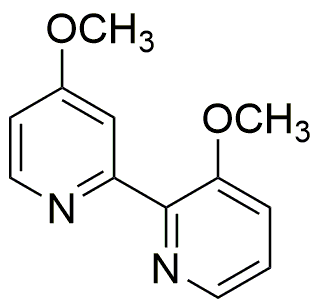4,4'-Dimethoxy-2,2'-bipyridyl is widely utilized in research focused on:
- Catalysis: This compound serves as a ligand in various catalytic processes, enhancing reaction efficiency in organic synthesis, particularly in transition metal catalysis.
- Electrochemistry: It is used in the development of electrochemical sensors, providing improved sensitivity and selectivity for detecting specific analytes in environmental monitoring.
- Pharmaceuticals: The compound plays a role in drug development, particularly in the design of new therapeutic agents that target specific biological pathways.
- Material Science: It is applied in the creation of advanced materials, such as organic light-emitting diodes (OLEDs), due to its favorable electronic properties.
- Research in Coordination Chemistry: This chemical is valuable in studying coordination complexes, aiding in the understanding of metal-ligand interactions and their applications in various fields.
General Information
Properties
Safety and Regulations
Applications
4,4'-Dimethoxy-2,2'-bipyridyl is widely utilized in research focused on:
- Catalysis: This compound serves as a ligand in various catalytic processes, enhancing reaction efficiency in organic synthesis, particularly in transition metal catalysis.
- Electrochemistry: It is used in the development of electrochemical sensors, providing improved sensitivity and selectivity for detecting specific analytes in environmental monitoring.
- Pharmaceuticals: The compound plays a role in drug development, particularly in the design of new therapeutic agents that target specific biological pathways.
- Material Science: It is applied in the creation of advanced materials, such as organic light-emitting diodes (OLEDs), due to its favorable electronic properties.
- Research in Coordination Chemistry: This chemical is valuable in studying coordination complexes, aiding in the understanding of metal-ligand interactions and their applications in various fields.
Documents
Safety Data Sheets (SDS)
The SDS provides comprehensive safety information on handling, storage, and disposal of the product.
Product Specification (PS)
The PS provides a comprehensive breakdown of the product’s properties, including chemical composition, physical state, purity, and storage requirements. It also details acceptable quality ranges and the product's intended applications.
Certificates of Analysis (COA)
Search for Certificates of Analysis (COA) by entering the products Lot Number. Lot and Batch Numbers can be found on a product’s label following the words ‘Lot’ or ‘Batch’.
Numéro de catalogue
Numéro de lot/série
Certificates Of Origin (COO)
This COO confirms the country where the product was manufactured, and also details the materials and components used in it and whether it is derived from natural, synthetic, or other specific sources. This certificate may be required for customs, trade, and regulatory compliance.
Numéro de catalogue
Numéro de lot/série
Safety Data Sheets (SDS)
The SDS provides comprehensive safety information on handling, storage, and disposal of the product.
DownloadProduct Specification (PS)
The PS provides a comprehensive breakdown of the product’s properties, including chemical composition, physical state, purity, and storage requirements. It also details acceptable quality ranges and the product's intended applications.
DownloadCertificates of Analysis (COA)
Search for Certificates of Analysis (COA) by entering the products Lot Number. Lot and Batch Numbers can be found on a product’s label following the words ‘Lot’ or ‘Batch’.
Numéro de catalogue
Numéro de lot/série
Certificates Of Origin (COO)
This COO confirms the country where the product was manufactured, and also details the materials and components used in it and whether it is derived from natural, synthetic, or other specific sources. This certificate may be required for customs, trade, and regulatory compliance.


